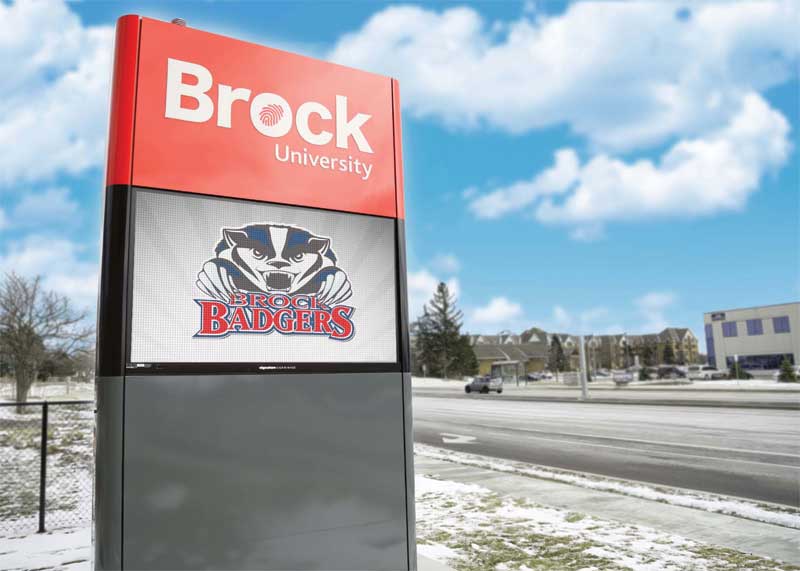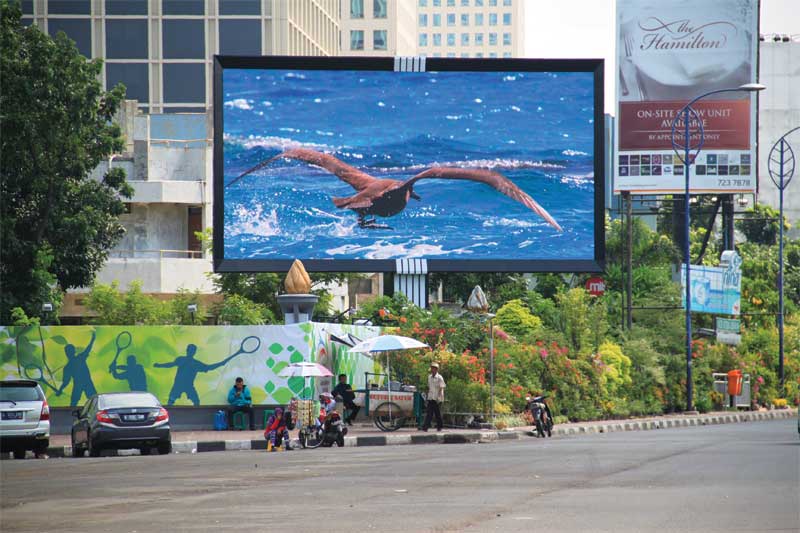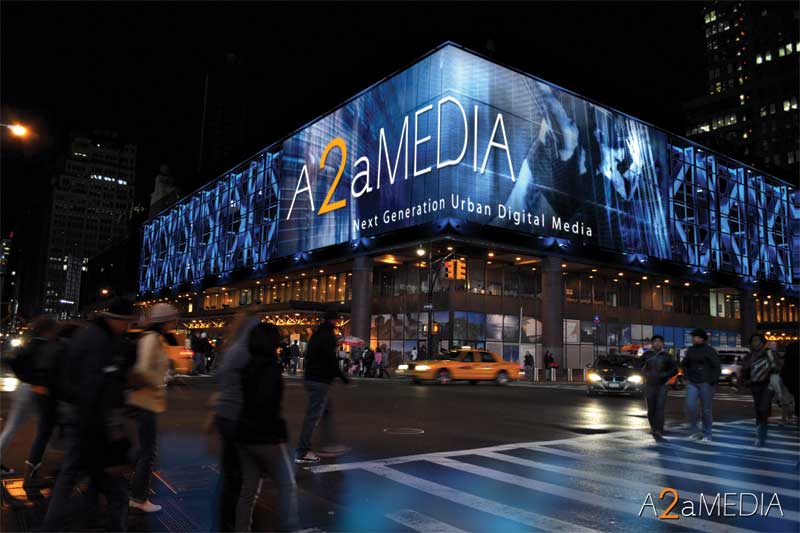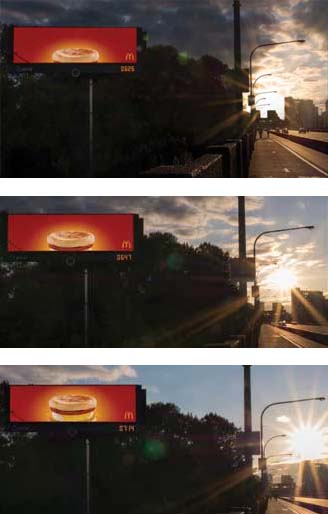Digital Signage: Planning and operating outdoor screens
by all | 21 June 2017 9:38 am
 [1]
[1]Photos courtesy Watchfire Signs
By Craig M. Berger
Outdoor digital signage has become less expensive and more accessible over time for retailers, institutions and other sign shop clients, but still requires a significant commitment in terms of money and time to source, install and manage. When developing a strategy and diving into all of the details of hardware and software,it is very important to understand the potential return on investment (ROI) and clearly lay out the entire process, to ensure a successful deployment.
Determining the return
Developing digital signage for exterior environments—whether oriented toward private businesses or public institutions—represents one of the most difficult challenges in the industry, as the medium has a particularly big impact on the community and on business communications. It calls for a deliberative strategy and process.
There are multiple metrics and approaches an organization can use to justify the implementation of digital signage. One simple option that encapsulates most of them is ‘return on experience’ (ROE), which is determined by considering the following three key elements:
Brand identity
An outdoor screen can support and even enhance an organization’s brand identity, with an enormous impact on the public’s view of it. This can be accomplished by showcasing engaging, non-obtrusive content, reducing visual clutter and serving as a community resource. Digital signage can provide powerful benefits at a shopping mall, for example, by reducing and simplifying a wide variety of messages.
Media channels
While digital out-of-home (DOOH) advertising can compete on cost-per-impression with many other paid media, including TV, radio and newspapers, this does not mean installing a screen will be cost-effective without a clear sales plan.
 [2]
[2]An outdoor screen can enhance a commercial location’s brand identity.
On the contrary, digital signage is relatively expensive to start up and operate, becoming cost-effective only when properly integrated into a larger strategy to maximize its number of impressions and drive the impact of its content.
Studies by the Sign Research Foundation (SRF), among others, have shown planning is particularly important for success with outdoor digital signage because there is wide variability in cost-per-impression across deployments, compared to other media.
Experience optimization
With a well-thought-out content plan, digital signage can help track the public’s habits and respond to them quickly, e.g. by changing messages based on the time of day or on increased business.
“Some restaurants link messaging to their food supply chain, to control waste by changing specials based on inventory,” says John Kunze, a division sales director for Watchfire, which manufactures outdoor digital signs.
 [3]
[3]LED screens have become the industry standard for digital billboards because they are ideal for displaying moving content from a distance.
Photo courtesy Daktronics
Developing a deployment process
As mentioned, to ensure a successful deployment, it is important to clearly lay out the complete process for development, including the following steps.
Strategic analysis
This is the phase when a digital signage audience’s demographics are broken down on the basis of age, education and socioeconomic factors, to help define a clear approach to content and messaging. The specific products, services and/or events that will be promoted by the screen will need to be listed, along with the relevant attributes of the advertiser(s).
This way, the message narrative—i.e. the specific mix of digital content the audience will respond best to—can be developed. It might include product ads, community information and event highlights relevant to specific target groups.
Design
The design of a digital sign is also crucial to maintaining or improving brand identity. A screen that is not well-suited for a certain environment can hurt more than it helps.
The design development phase should involve location planning, including a complete legibility analysis based on the sign’s visual context, local sign code limitations and average vehicular/pedestrian speeds. Choosing the size of the screen, for example, may be a balancing act between optimal legibility and what is permitted by existing sign bylaws.
Another factor is how the screen will fit into the larger environment, including the physical landscape and the overall architecture of the site. This will inform illumination levels and other elements of the sign’s functionality.
 [4]
[4]Legibility is often an important issue when screens are viewed from vehicles moving at high speeds.
Photo courtesy Bell Media
Content development
Designing strong content for digital signage is a comprehensive process, combining multiple technical areas. The most important is the content management system (CMS) software.
In fact, no area has seen more innovation than CMS development. There are many options available today that focus on specific needs, such as ease of inputting information, the ability to change content based on external factors and convenient access to special effects.
It is important to keep the realities of the outdoor environment in mind. Many of the special effects digital signage is capable of are lost on viewers passing by in vehicles at high speeds. Instead, messages need to be simple. Only at the pedestrian level can more complex content prove effective on an outdoor screen.
Similarly, active and passive interactivity may be integrated for pedestrians, such as facial recognition software. Such features are less relevant with a screen for vehicular audiences.
The dynamic nature of digital signage is its best attribute, yet often the most underused. An outdoor screen should be seen as a tool for experimenting with different messages, monitoring the results, analyzing changing conditions and reacting to them.
 [5]
[5]With a ‘media mesh’ installation, the LEDs are spaced apart, allowing people inside a building to see outside.
Photo courtesy Business Wire
Hardware selection
The hardware options for exterior digital signage vary significantly in terms of price and resolution.
Light-emitting diode (LED) screens are the industry standard for scrolling message signs and digital billboards, as they are ideal for displaying moving content from a distance. Many resolutions are available, though there are considerable cost differences from low to high.
Beyond billboards, one of the advantages of LED screens is they can be arranged in different shapes to suit a building’s architecture. There are even ‘media mesh’ options where the LEDs are spaced apart, allowing people inside the building to see outside.
Another emerging option is to arrange organic LEDs (OLEDs) into a transparent or translucent screen. OLEDs lend themselves well to intricate shapes and can handily turn an existing surface, such as a window, into a screen.
Liquid crystal displays (LCDs) dominate indoor digital signage deployments, but they have also become popular for outdoor applications, housed behind glass façades or within weather-resistant enclosures. These are more typically pedestrian-facing ‘streetscape’ deployments in big cities.
Digital projection can be cost-effective for both small- and large-scale applications. Although it is only useful at night, the technology is reportedly used in 25 per cent of all digital signage applications.
Ongoing management and maintenance
All digital signs require extensive and ongoing attention to maintain their effectiveness, but the need is clearest with high-profile outdoor screens. When a digital sign is ‘broken,’ it has a significant negative impact on its owner’s brand identity.
 [6]
[6]LCDs are also often used outdoors, but within weather-resistant housings.
Photo courtesy Nanov Display
The ability to remotely monitor and update screen content is crucial. Larger operators can co-ordinate multiple digital billboards asa platform for national ad campaigns.
The ability to manage illumination levels remotely is also useful. Changing a screen’s brightness for day and night will both extend the life of the hardware and improve acceptance by the community. In some cases, this feature is required for bylaw compliance.
“There is a significant difference of as much as 70 to 90 per cent between luminescence needs during the day or night and, for that matter, between sunny and cloudy days,” says Philip M. Garvey, senior research associate for the Larson Institute at Pennsylvania State University, which has studied digital signage in depth.
Content legibility
As much as people’s attention is naturally attracted to the dynamic nature of digital signage, it is a double-edged sword, because changing content can be more difficult to read than a printed graphic. One of the biggest challenges in the industry has been to develop high-quality, consistently legible messaging.
Effective messages
Many sign codes prohibit flashing, scrolling or moving messages on digital screens. Instead, a static image must be displayed for a certain minimum duration—e.g. five seconds—before the next one appears. These codes usually take their cues from the digital billboard industry, where large screens are viewed from vehicles moving at high speeds.
A more comprehensive approach to determining how changeable messages will appear should also be based on the size of the billboard and the complexity of the desired messages. Research suggests brief messages should comprise no more than three lines of text, with no more than 20 characters per line. It should be possible for each message to be read twice by a driver moving at the speed limit, which typically requires four seconds
of viewing time for every 10 seconds the sign itself is visible to the viewer. Each message should convey a complete thought.
“Eight seconds between messages will produce the strongest results in terms of legibility,” says Garvey. “The average driver can digest two messages from when they first see a message until they pass the sign. That usually is a 16-second period, at typical driving speeds and sign sizes.”
In other words, even putting sign codes aside, industry guidelines themselves suggest digital billboard content should be basic, clear and not especially dynamic. The ads must be short, but also relevant, to be effective. Ultimately, most legibility issues for digital billboards are the same as for traditional signs.
For pedestrian-facing digital signage, on the other hand, content may be much more complex, with a mix of advertising, information and even interactivity. Storytelling can give ad campaigns a strong impact.
SRF studies show messages that are poorly designed often go ignored. The increased ubiquity of digital displays has made viewers accustomed to them, so if content is not visually stimulating, compelling and relevant,it will remain invisible. Certainly, imagery should be at the same level of quality as printed graphics.
Hardware issues
The legibility of content will depend not only on how it is designed, but also on how it is displayed, in terms of the hardware used. Lower-resolution screens have come to be seen as detrimental to their owners’ brand identity, to the point where some municipal governments are beginning to look into regulating resolution the same way they do with illumination levels.
This is one of the reasons LCDs, which provide the highest resolutions, are dominant at the pedestrian level, while arrays of red, green and blue (RGB) LEDs, which are brighter and more easily seen from a distance, are integrated into buildings and used as billboards. Content needs to be designed accordingly.
“LED screens with a tighter pixel pitch become more legible,” says Garvey. “A pitch between 10 and 12 mm (0.39 and 0.47 in.) is quickly becoming the standard outdoors and some manufacturers are pushing the envelope with 8.5 mm (0.33 in.).”
Nighttime digital projections, on the other hand, tend to map three-dimensional (3-D) images on large-scale surfaces, rather than focusing on text. The technology is generally better-suited for dramatic visual effects than for messages.
Environmental integration
The success of exterior digital signage networks has not come without considerable conflict with urban and suburban communities, particularly where there is a perceived lack of integration with the landscape or architecture of the surrounding environment. As a result, some governments have worked to develop new codes that require the overall design of a sign to be considered before approving the use of a large screen.
 [7]
[7]Content can be changed creatively based on the time of day.
Photos courtesy Bell Media
Media architecture
For the above reasons, it is important to place any outdoor digital signage strategy within the context of the installation location(s). Europe has taken the lead, both academically and practically speaking, in the field of ‘media architecture,’ with many summits and events dedicated to best practices for integrating digital screens in cities.
The broader purpose of this movement is to make dynamic media a more fundamental part of architectural design, to enhance and enliven communities. In this context, digital signage extends well beyond advertising as an artistic medium, with content closely aligned to the public realm. Generally, these types of projects require extensive expertise in multiple fields, even if they are developed on a relatively small scale.
Monument signs
In many cases, an outdoor digital screen is part of a larger, free-standing monument or pylon sign, serving as a highly visible landmark along a street. One reason for this trend is the esthetic desire to hide or enhance the surrounding ‘box’ and reduce visual clutter.
Another is the opportunity to enhance the digital signage with other dynamic illumination effects to attract attention, though it is important not to allow the lighting to compete directly with the screen. Subtle approaches like cove lighting and ‘washes’ can add pleasant accenting to the monument, while still allowing the screen to be dominant.
Sign systems
Another strategy is to use multiple digital signs for greater messaging effect. In urban areas, a series of outdoor screens can help define a path or gateway.
Emerging technologies
As dynamic, high-resolution imagery becomes more cost-effective for small business owners and other sign shop clients, new technologies have also emerged that lend themselves to the goal of architectural integration.
Smaller screen modules can be interconnected to form flexible and/or creatively shaped displays. This technology can be scaled for installation on everything from guard rails to street furniture.
“People are getting bored with digital screens that just look like another TV,” says Robert Harrington, CEO of Sunrise Systems, which develops LED ticker and transit displays. “Funky shapes and curves are popular today.”
Similarly, the aforementioned OLEDs are enabling screens to be wrapped around building columns.
“OLEDs are thin and can bend more flexibly than any other screen on the market,” Harrington says. “They will revolutionize the way we look at physical environments, where digital elements can be part of any fixtures.”
Craig M. Berger is chair of the visual presentation and exhibition design program at the Fashion Institute of Technology (FIT). This article is based on a series of reports he wrote for the International Sign Association (ISA). For more information and the full reports, visit www.signs.org/research[8].
- [Image]: https://www.signmedia.ca/wp-content/uploads/2017/06/Brock-University-Sign-2.jpg
- [Image]: https://www.signmedia.ca/wp-content/uploads/2017/06/Watchfire1-e1497894719809.jpg
- [Image]: https://www.signmedia.ca/wp-content/uploads/2017/06/Daktronics1.jpg
- [Image]: https://www.signmedia.ca/wp-content/uploads/2017/06/National-flag-day-media-10022015-DSB-002-e1497894948396.jpg
- [Image]: https://www.signmedia.ca/wp-content/uploads/2017/06/mediamesh1.jpg
- [Image]: https://www.signmedia.ca/wp-content/uploads/2017/06/Sheridan-e1497895200232.jpg
- [Image]: https://www.signmedia.ca/wp-content/uploads/2017/06/mcd_edit.jpg
- www.signs.org/research: http://www.signs.org/research
Source URL: https://www.signmedia.ca/digital-signage-planning-and-operating-outdoor-screens/